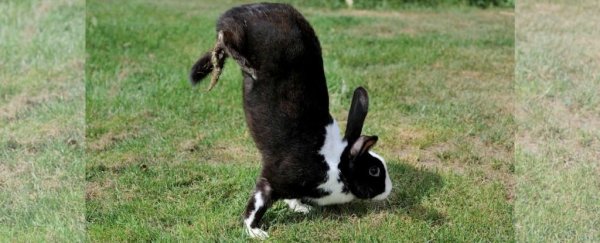Selective breeding by humans has led to some incredibly odd and unfortunate pets over the years, and the sauteur d'Alfort rabbit is among the strangest of the lot.
This rare breed of bunny does not hop or walk like any other rabbit or hare in existence. When the sauteur is ready to go, it kicks its hind legs into the air and bounces forward on its front paws, like a human acrobat walking on their hands.
While this may seem like an amusing trait, it sadly comes with other debilitating problems too. Now, the one bunny that can't hop properly has helped us better understand the genetics of hopping in mammals.
Crossing a single male sauteur with a single female of the New Zealand white breed and then crossing the resulting offspring, researchers raised 52 bunnies, 23 percent of which carried two copies of the mutant gene similar to the original father. These numbers match the statistics expected when there is only one recessive gene involved in a mutation.
Pooling the DNA of the sauteur and non-sauteur young, researchers used whole-genome sequencing to compare the two groups. In the end - as they anticipated - there was only one gene that stood out.
The cause of the sauteur's defective jumping appears to lie with a mutation in an evolutionary conserved site of a gene known as RORB, which provides instructions to mammalian cells so they can create certain proteins.
RORB proteins are generally found throughout the rabbit nervous system, where they help turn genetic code into a protein building template. This particular mutation, however, causes a sharp decrease in the number of spinal cord neurons that can actually produce this protein.
Two copies of the RORB mutation, in fact, resulted in no proteins in the spinal cord at all, and this was tied to an inability to hop. Other rabbits in the litter capable of jumping with their hind legs showed no such protein loss.
The RORB gene, the authors conclude, must be what allows rabbits to bound around. It could also be the key to other mammal hopping, too.
Over the years, there's been a lot of scientific interest in the special physiology and biomechanics that allow mammals - like kangaroos, bunnies, hares and some mice - to hop, but the underlying genetics of this feat have rarely been considered.
One of the few studies out there recently found mice with the same RORB mutation as sauteur rabbits also cannot hop like normal. Instead, these rodents waddle around on their front paws like a duck, with their tails and hind legs sticking up in the air.
"I spent four years looking at these mice doing little handstands, and now I get to see a rabbit do the same handstand," neuroscientist Stephanie Koch from the University College London told Science News. "It's amazing."
Koch's study on rabbits is the first to describe a specific gene required for leaping or hopping, and it lines up extremely well with what she's been observing in mutant mice.
Similar to mutant rodents, sauteur rabbits also show other anatomical defects beyond their strange walk. Many are born blind and develop cataracts in their first year of life. RORB knock-out mice also show retinal degeneration.
In mice, the RORB gene appears to play an essential role in differentiating cells in both the brain's cortex and the retina. It might also do something similar in the spinal cord, which is involved in the regulation of sensory information and locomotion among mammals.
As such, this lack of proteins might be what is causing the hind legs of rabbits and mice to lift instead of leaping. In sauteur rabbits, for instance, the RORB mutation appears to cause defects in the differentiation of spinal cord interneurons, although whether this is actually causing the bizarre locomotion remains unclear.
"In addition to its expression in the spinal cord, RORB is also expressed in many regions in the brain such as the primary somatosensory, auditory, visual and motor cortex, in some thalamus and hypothalamus nuclei, in the pituitary gland and in the superior colliculus," the authors write.
"Thus, we cannot exclude the possibility that an alteration of RORB function in the brain contributes to the locomotion phenotype characteristic for the sauteur rabbits."
The effects of the RORB mutation will require more study, but it's obvious it's involved somehow. This was the only variant identified in the whole genome sequence of rabbits that had any impact on hopping.
While there might well be more genes involved in bunny hopping, it seems that poor sauteur rabbits have certainly pointed us in the direction of one.
The study was published in PLOS Genetics.
